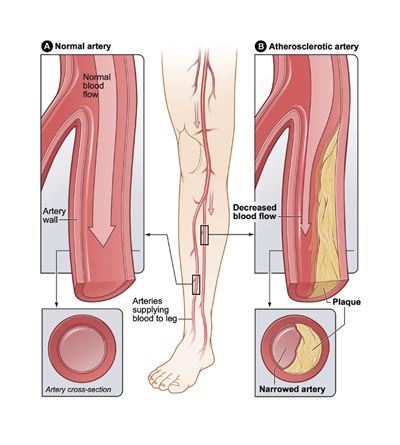Artery disease (atherosclerosis) usually doesn't cause symptoms until it severely narrows or totally blocks an artery. Many people don't know they have the disease until they have a medical emergency, such as a heart attack or stroke. Some people may have signs and symptoms of the disease, but this depends on which arteries are affected.
Coronary Arteries
Coronary arteries supply oxygen-rich blood to the heart. When plaque narrows or blocks these arteries—a condition called coronary artery disease (CAD) or coronary heart disease (CHD) occurs. A common symptom is angina. Angina is chest pain that occurs when your heart doesn't get enough oxygen-rich blood.
Angina may feel like pressure or a squeezing pain in your chest. You also may feel it in your shoulders, arms, neck, jaw, or back. It tends to get worse with activity and go away when you rest. Emotional stress also can trigger the pain.
Carotid Arteries
Carotid arteries supply the brain with oxygen-rich blood. When plaque narrows or blocks them (a condition called carotid artery disease), you may experience the symptoms of a stroke, including:
- Sudden weakness or numbness in the face or limbs, often on just one side of the body
- Inability to move one or more of your limbs
- Trouble speaking and understanding
- Sudden trouble seeing in one or both eyes
- Dizziness or loss of balance
- A sudden, severe headache with no known cause

PERIPHERAL ARTERY DISEASE
The National Heart, Lung, and Blood Institute (NHLBI), the P.A.D. Coalition, and other vascular and heart disease organizations are promoting September as National Awareness Month for peripheral artery disease (P.A.D.) and other vascular diseases. (See "To Find Out More")
Peripheral Arteries
Plaque also can build up in the major arteries supplying oxygen-rich blood to the legs, arms, and pelvis. This is called peripheral artery disease (P.A.D.). If these major arteries are narrowed or blocked, it can lead to numbness, pain, and, sometimes, dangerous infections.
Just like clogged arteries in the heart, clogged arteries in the legs raise the risk for heart attack or stroke. P.A.D. affects approximately 9 million Americans. It is a chronic disease requiring lifelong care. (See illustration on right.)
Should You Be Tested for P.A.D.?
National medical guidelines recommend that the following individuals be tested for P.A.D. Review these with your health professional. Place a check in any box that applies.
- I am under 50 years of age, have diabetes and at least one other risk factor:
- History of smoking
- Abnormal cholesterol
- High blood pressure
- I am 50 years or older and have diabetes
- I am 50 years or older and am a former or current smoker
- I am 70 years or older
- I have one or more symptoms of PAD:
- Fatigue, heaviness, tiredness or cramping in the leg muscles (calf, thigh or buttocks) that occurs during activity such as walking and goes away with rest
- Foot or toe pain at rest that often disturbs sleep
- Skin wounds or ulcers on the feet or toes that are slow to heal (or that do not heal for 8 to 12 weeks)
If you check one or more boxes, talk to your health professional about being tested for P.A.D.
Source: National Heart, Lung, and Blood Institute; P.A.D. Coalition
